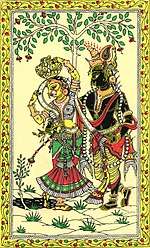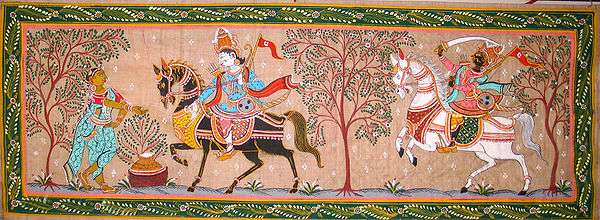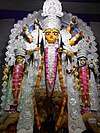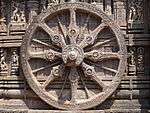Pattachitra
Pattachitra or Patachitra is a general term for traditional, cloth-based scroll painting,[5] based in the eastern Indian states of Odisha[6][7] and West Bengal.[8] Pattachitra artform is known for its intricate details as well as mythological narratives and folktales inscribed in it. Pattachitra is one of the ancient artworks of Odisha. Pattachitras are a component of an ancient Bengali narrative art, originally serving as a visual device during the performance of a song.[9]
| Patachitra Pattachitra | |
|---|---|
| Geographical indication | |
_(1439702942).jpg) 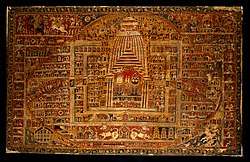 Odisha Pattachitra and West Bengal Patachitra | |
| Alternative names | OD: ପଟ୍ଟଚିତ୍ର BN: বাংলার পটচিত্র |
| Description | Pattachitra is an old traditional art of Odisha and West Bengal |
| Area |
|
| Country | India |
| Registered | |
| Material | Cloth, Paper, Color, Theme |
| Official website | ipindiaservices.gov.in |
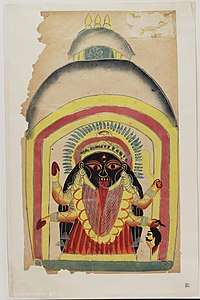
Significance of the name
In the Sanskrit language, "Patta" literally means "cloth" and "Chitra" means "picture". Most of these paintings depict stories of Hindu deities.[10]
Odisha Pattachitra
Pattachitra is a traditional painting of Odisha, India.[1] These paintings are based on Hindu mythology and specially inspired by Jagannath and Vaishnava sect.[11] All colours used in the Paintings are natural and paintings are made fully old traditional way by Chitrakaras that is Odiya Painter. Pattachitra style of painting is one of the oldest and most popular art forms of Odisha. The name Pattachitra has evolved from the Sanskrit words patta, meaning canvas, and chitra, meaning picture. Pattachitra is thus a painting done on canvas, and is manifested by rich colourful application, creative motifs, and designs, and portrayal of simple themes, mostly mythological in depiction.[12] The traditions of pattachitra paintings are more than thousand years old.[13][14]
Origin and History
The paintings of Odisha can be divided into three categories from the point of view of medium, i.e. paintings on cloth or 'Patta Chitra', paintings on walls or 'Bhitti Chitra' and palm leaf engravings or "Tala Patra Chitra' or "Pothi, Chitra'.[15] The style of all these remains more or less the same at a specific time because the then artists were commissioned to work in all these media, it is believed.
The painting the 'pattachitra' resemble the old murals of Odisha especially religious centres of Puri, Konark and Bhubaneshwar region, dating back to the 5th century BC. The best work is found in and around Puri, especially in the village of Raghurajpur.[16]
This old tradition of Odia painting still survives in the places like Puri,Raghurajpur, Paralakhemundi, Chikiti and Sonepur. Lord Jagannath in the present from is being taken as the origin of the Patta style. The colour schemes of the deities of Puri are quite similar to those of the Patta style. The oldest record of Patta Paintings does not probably go beyond the establishment of the present shrine of Shri Jagannath at Puri. It may be due to the fact that paintings do not survive like sculptures. The paints inside the shrines of Lord Jagannath at Puri make the date probable. The oldest classical marble paintings of Sitabanji at Keonjhar do not conform to the present style of Patta painting wholly. The wooden statues of the three deities are also covered with cloth and then overlaid with glue mixed with chalk, and then given paint only with four limited colours of red, yellow, white and black. The deities who are held in high esteem by the Odias and who inspire religion, life and activity of the people also carry with them a tradition of art and painting which is as old as the deities themselves. If the Savara origin of Jagannath is accepted, the date of the Patta paintings can be dated back to an earlier period. These paintings were originally substitutes for worship on days when the temple doors were shut for the 'ritual bath' of the deity.
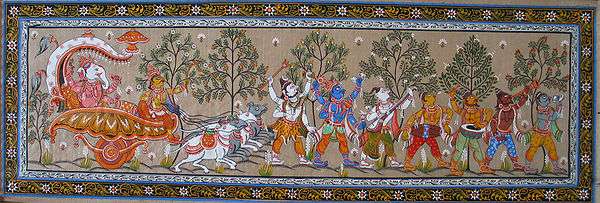
Theme and Style
The theme of Odia painting centres round the Jagannath and the Vaishnava sect. Since beginning of Pattachitra culture, Lord Jagannath who was an incarnation of Lord Krishna has been the major source of inspiration. The subject matter of Patta Chitra is mostly mythological, religious stories and folk lore. Themes are chiefly on Lord Jagannath and Radha-Krishna, different "Vesas" of Shri Jagannath, Balabhadra and Subhadra, temple activities, the ten incarnations of Vishnu basing on the 'Gita Govinda' of Jayadev, Kama Kujara Navagunjara, Ramayana, Mahabharata.[17] The individual paintings of gods and goddesses are also being painted.
The Pattachitra style are mix of both folk and classical elements but leanings more towards folk forms. The dress style has Mughal influences. All of the poses have been confined to a few well-defined postures. These are not free from monotonous repetitions, though at times this is necessary to accentuate the narrative character of the style. The lines are bold and clean and angular and sharp. Generally, there are no landscapes, perspectives, and distant views. All the incidents are seen in close juxtaposition. The background on which the figures are represented, is delineated with decorations of flowers and foliages and is mostly painted in red colour. All the paintings are given decorative borders. The whole painting is conceived in the form of a design on a given canvas.
The themes may be classified into following categories[18]
- Jagannath paintings
- Vaishnav Paintings
a)Bhagabat paintings b)Ramayana paintings
Technique
Traditionally the painters are known as chitrakars. A patta painter's home with all the members of family is his studio. Woman members prepare the glue, the canvas and apply colours what we call the fill-in, and give the final lacquer coating. The master hand, mostly the male member, draws the initial line and gives the final finishing. Patta paintings are done on small strips of cotton cloth. The canvas is prepared by coating the clothing with a mixture of chalk and gum made from tamarind seeds. Then it is rubbed by taking the help of two different stones and then the cloth is dried. The mixture of gum and chalk gives the cloth's surface a leathery finish on which the artists paint with vegetable, earth and stone colours.[20]
The painters do not use pencil or charcoal for the preliminary drawings. They are so expert in the line that they simply draw directly with the brush either in light red or yellow. Then the colours are filled in. The final lines are drawn and the patta is given a lacquer coating to protect it from weather, thus making the painting glossy. This process of glazing or varnishing is quite interesting. The painting is held over a fireplace so that the back of the painting is exposed to heat. On the surface of the painting fine lacquer is applied.
Colour
In the 16th century, with the emergence of Bhakti movement the paintings of Radha and Krishna were painted in vibrant shades of orange, red and yellow. There are typical scenes and figures like Krishna, Gopis, elephants, trees and other creatures are seen in these paintings. Krishna is always painted in blue and Gopis in light pink, purple or brown colours.[21]
The painters use vegetable and mineral colours without going for factory-made poster colours. They prepare their own colours.[22] White colour is made from the conch-shells by powdering, boiling and filtering in a very hazardous process. It requires a lot of patience. But this process gives brilliance and premanence to the hue. 'Hingula', a mineral colour, is used for red. 'Haritala', king of stone ingredients for yellow, 'Ramaraja' a sort of indigo for blue are being used. Pure lamp-black or black prepared from the burning of coconut shells are used.[23] There was no blue either cobalt or ultramarine in the earlier colour schemes. The colours used in the Patta paintings are primarily bright colours, limited to red, yellow, indigo, black and white. The brushes that are used by these 'Chitrakaras' are also indigenous and are made of hair of domestic animals. A bunch of hair tied to the end of a bamboo stick make the brush.[24]
Palm leaf Pattachitra
Palm leaf pattachitra which is in Oriya language known as Tala Pattachitra drawn on palm leaf. First of all palm leaves are left for becoming hard after being taken from the tree. Then these are sewn together to form like a canvas. The images are traced by using black or white ink to fill grooves etched on rows of equal-sized panels of palm leaf that are sewn together. These panels can also be easily folded like a fan and packed in a compact pile for better conservation. Often palm-leaf illustrations are more elaborated, obtaining by superimposing layers that are glued together for most of the surface, but in some areas can open like small windows to reveal a second image under the first layer.[25]
Bengal Patachitra
- The Bengal Patachitra
_(1439706046).jpg) Patachitra of Naya village
Patachitra of Naya village_(1438842569).jpg) Patachitra of Naya village
Patachitra of Naya village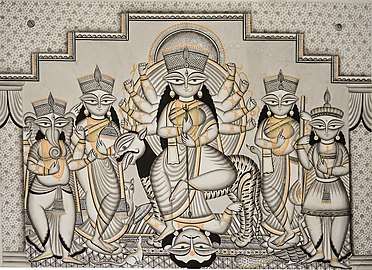 Goddess Durga and her family in Medinipur Patachitra
Goddess Durga and her family in Medinipur Patachitra.jpg) Manasa in Kalighat Patachitra
Manasa in Kalighat Patachitra
The Bengal Patachitra refers to the painting of West Bengal. It is a traditional and mythological heritage of West Bengal. The Bengal Patachitra is divided into some different aspects like Durga Pat, Chalchitra, Tribal Patachitra, Medinipur Patachitra, and Kalighat Patachitra.[26] The subject matter of Bengal Patachitra is mostly mythological, religious stories, folk lore and social. The Kalighat Patachitra, the last tradition of Bengal Patachitra is developed by Jamini Roy. The artist of the Bengal Patachitra is called Patua.[27]
Patachitra of Naya village in West Bengal is now collected in National Museum of Ethnology (henceforth MNE) in Lisbon.[28]
Origin and History

Patachitra is known for its excellent play of colour. It is a traditional folk art form of rural Bengal. There are some controversial opinions about the dates of ancient Patas. But it has been suggested on the basis of historical themes connected with the accompanied songs like Patua Sangeet. It dates back to the Pre- Pala period which is still tucked away with small villages of Midnapore, Bankura, Purulia, Howrah, Hooghly and 24 Parganas. Bengal Patachitra is referred to in the Buddhist literature in 1st century A.D., in Haribansha in 2nd century, in Abhigyanashakuntalam and Malavikagnimitra in 4th century, Harshacharita and Uttararamacharita in 6th and 7th-8th centuries respectively.[29]
In his book Folk Art of Bengal, author Ajitcoomar Mookerjee has mentioned that there are some Jadu-Patuas painting of mural style in the temples of Bankura District.[30]
Theme and Style
There are many types of Pots like religious, secular. Religious pots encompass the story of Hindu epics like, mythology, Ramayana, Mahabharata narrating stories of Hindu gods and goddesses like, Krishna, Chaitanya, Kali, Shiba and the indigenous Bengali folklore of Manasha and Chandi, Behula and Lakshinder being the most popular. Secular pots depicts important news events, scandals accidents etc. such as bus accidents at Narayangarh, rural elections, the rationing system, family planning, evils of the dowry system etc. Every Patachitra has a song related to it, which the artists sing while unfurling the Patachitra. Singing pot in Bengal is called Patua Sangeet. Patua Sangeet or Poter Gan is a cultural tradition of the singing Bengal Patachitra. It is performed by Patua.[31] It is famous in the village part of West Bengal like Birbhum, Jhargram, Bardhaman and Murshidabad as a folk song of West Bengal.[9]
Aspects of painting
Bengal Patachitra painting has a different type of motive and aspects that unrolled the Bengali culture. Using the mythological epic and the natural color it is one of the individual characteristics of the Bengal Patachitra.
Chalchitra
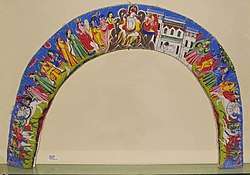
Chalchitra is a part of Bengal Patachitra, It referred to the Debi Chal or Durga chala, the background of the Durga Pratima or idol.[32] Patua, the artists of Chalchitra called it as Pata Lekha, means the writing of Patachitra.[27] 300–400 years old idols of Nabadwip Shakta Rash used Chalchitra as a part of Pratima. At a time, the use of Chalchitra became fade, but now it has a great popularity.[33] Chalchitra artist of Nabadwip, Tapan Bhattacharya said-
It's good to see a lost painting coming back around.
Durga Pot
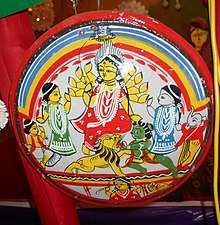
Durga pot or Durga sara is recognised as the worshiped patachitra. It worshiped in the Hatsarandi Sutradhar society of Birbhum district on Durga puja time. This type of patachitra is also worshiped is Katwa. Durga Pot has a semi-circular Patachitra where Patachitra of Durga is in the middle position. Ram, Sita, Shib, Nandi-Vringi, Brahma, Vishnu, Shumbha-Nishumbha are painted on this kind of Chalchitra. Krishnanager Rajrajeshwari Durga is seen to be uniquely noticed. In the middle of the Chalchitra, there is Panchanan Shib and Parvati is beside him, on one side there is Dasha-mahabidya and the other side, there is Dashabatar.[34]
Technique
The Patachitra of different districts of West Bengal are characterized by many peculiarities in colour and design. The patachitra of Manbhum, now known as Purulia can easily be distinguished by their preference for one particular shade of burnt sienna relieved by white and yellow patches and densely packed composition. The seated figures of Dasaratha and Chand Sadagar of Medinipur crowning the Ramayana and Kamale-Kamini scrolls are impressive and monumental.[35] In the scrolls of pot of Birbhum, Bankura and Burdwan preference for Indian red background usually found, the scrolls of Hooghly preferred a dark brown. The Hooghly and Manbhum 'pats' are peculiar and definitely modernistic with the abstract linear treatment.[36]
Colour
Use of natural color is one of the individual characteristics of the Bengal Patachitra. In general, blue, yellow, green, red, brown, black and white are used in the Patachitra of West Bengal. Chalk dust is used for white color, pauri for yellow color, cultivated indigo for blue, bhushakali for black and mete sindur for red color.[37]
Artists
Bengal Patua artists carry the occupational surname of 'Chitrakar'. They are concentrated in the village of Naya in Medinipur district of West Bengal. Prominent artists include Khandu and Radha Chitrakar and their children Bapi, Samir, Prabir, Laltu, Tagar, Mamoni and Laila Chitrakar. Monimala is known for her use of bold, primal colours and the development of her own iconographic style.[38]
Geographical Indication of Pattachitra
Geographical indication of Patachitra is registered under to different state of India as the style and motif of Odisha and West Bengal Patachitra are so different. The Patachitra of Odisha is registered as Orissa Pattachitra.[1][39] The Patachitra of West Bengal is registered as Bengal Patachitra.[40][41][42]
References
Citations
- http://odisha.gov.in/e-magazine/Orissareview/2010/November/engpdf/46-48.pdf
- "Orissa Pattachitra". Retrieved 23 July 2018.
- Bose, Nirmal Kumar. 1953. Folk religion of Bengal, part I number I (A study of the Vrata rites).C. Kar, Benoy Bose Road, Calcutta, India
- "Patachitra: Ancient scroll painting of Bengal". Media India Group. 2017-04-26. Retrieved 2018-05-18.
- SenGupta, pp. 13.
- http://www.daricha.org/sub_genre.aspx?ID=39&Name=Patachitra
- "Patta Chitra".
- Rahaman, Md Motiur; Hom Choudhury, Mahuya; Sengupta, Sangita (2016-02-29). "VALIDATION AND GEOGRAPHICAL INDICATION (G.I) REGISTRATION OF PATACHITRA OF WEST BENGAL- ISSUES AND CHALLENGES". Cite journal requires
|journal=(help) - "Myths and Folktales in the Patachitra Art of Bengal: Tradition and Modernity - The Chitrolekha Journal on Art and Design". The Chitrolekha Journal on Art and Design. 2015-08-02. Retrieved 2018-05-18.
- SenGupta, pp. 12.
- "Patta Chitra".
- http://india.gov.in/knowindia/pattachitra.php
- http://craftorissa.com/b2c/product_info.php?products_id=112%5B%5D
- "Pattachitra Painting". archive.india.gov.in.
- "Crafts of India -Patachitra - Introduction". Unnati Silks.
- "Pattachitra Arts - Orissa | Handmade Crafts directly from Craftsmen". Archived from the original on 2011-02-27. Retrieved 2010-02-18.
- "Indian Art » Blog Archive » Patta Chitra Paintings". indianart.in.
- categories of Pattachitra Archived 2010-07-29 at the Wayback Machine
- https://www.devotionalstore.com/blogs/devotional-blog/traditional-arts-of-odisha-pattachitra-painting
- The meticulous process of Pattachitra paintings
- Radha, Krishna and Gopis in Pattachitra
- "How to do Pattachitra". Archived from the original on 2010-07-29. Retrieved 2010-03-22.
- natural colours used in Pattachitra Archived 2010-07-29 at the Wayback Machine
- colour brushes used in Pattachitra Archived 2010-07-29 at the Wayback Machine
- "Patta paintings". Archived from the original on 2009-01-06. Retrieved 2010-03-26. Palm leaf pattachitra
- বন্দ্যোপাধ্যায়, দেবাশিস. "পটচিত্রের চাহিদা বাড়ছে নবদ্বীপের রাসে". Anandabazar Patrika (in Bengali). Retrieved 2018-05-11.
- Giusti, M. and Chakraborty, U. (ed.). Immagini Storie Parole. Dialoghi di formazione coi dipinti cantati delle donne Chitrakar del West Bengal. Mantova: Universitas Studiorum, 2014, ISBN 978-88-97683-39-1
- Ponte, Inês (2015-05-13). "Cosmopolitan impressions from a contemporary Bengali patachitra painting museum collection in Portugal". Ateliers d'Anthropologie (41). doi:10.4000/ateliers.9771. ISSN 1245-1436.
- Roy Niranjan (1973), The Patas and Patuas of Bengal. Indian Publications Calcutta, Page number 54-55 (Annexure C,V)
- Mookerjee Ajitcoomar (1939), Folk Art of Bengal. university of calcutta, Page number 18-19 (Annexure C.Vll)
- Sri Ashutosh Bhattacharya. Bangiyo Loko-Sangeet Ratnakosh. Kolkata: Paschimbanga Loko Sanskriti Gobeshona Kendra. p. 1041.
- tarapada santra (2000). Paschimbanger lokoshilpa o lokosamaj. Kolkata: Kolkata: lokosanskriti o adibasi sanskriti kendra. p. 12.
- বন্দ্যোপাধ্যায়, দেবাশিস. "পটচিত্রের চাহিদা বাড়ছে নবদ্বীপের রাসে". Anandabazar Patrika (in Bengali). Retrieved 2018-04-14.
- ভট্টাচার্য, বিভূতিসুন্দর. "অবক্ষয় আর অবলুপ্তির মাঝে বাংলার চালচিত্র - Anandabazar". Anandabazar Patrika (in Bengali). Retrieved 2018-04-14.
- Craft council of West Bengal-1985-86, The Jarana Patachitra of Bengal- Mahamaya, p-112
- D. P. Ghosh, FOLK ART OF BENGAL, Visvabharati, p-4
- http://ipindiaservices.gov.in/GI_DOC/564/564%20-%20Statement%20of%20Case%20-%2017-08-2016.pdf
- Nair, Sunita (2018). Indigenius Artists India. Mumbai: Sunita Nair. pp. 135–137. ISBN 978-93-5311-387-2.
- "Geographical Indications of India". ipindia.nic.in. Archived from the original on 2013-08-26.
- "Registered Gls | Geographical Indications | Intellectual Property India". www.ipindia.nic.in. Retrieved 2018-05-14.
- "Bengal handicrafts to get new fillip with GI tags". The Hindu. 2016-08-16. ISSN 0971-751X. Retrieved 2018-05-14.
- Roy, Tasmayee Laha (2016-08-22). "West Bengal seeks geographical indication tag for handicrafts". The Economic Times. Retrieved 2018-05-14.
Further reading
- Kossak, Steven (1997). Indian court painting, 16th-19th century. New York: The Metropolitan Museum of Art. ISBN 0-87099-783-1. (see index: p. 148-152)
External links
| Wikimedia Commons has media related to Pattachitra. |
